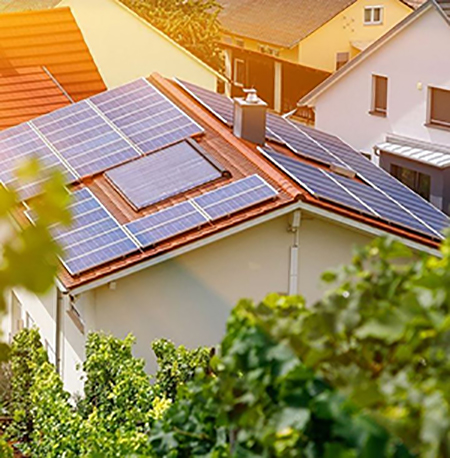When the summer sun scorches the land, PV power plants begin the busiest power producing season of the year. However, behind this dazzling light, high temperatures, powerful radiation, and other severe environments provide unprecedented obstacles for solar power plant operation and maintenance. To ensure that PV power plants can operate efficiently and steadily in such a harsh environment, this article will examine the common problems encountered during the operation and maintenance of PV power plants during the summer and provide you with a series of targeted solutions to help you easily cope with the challenges of ensuring the stable output of green energy.

First, the efficiency of PV modules diminishes in a high temperature environment.
High summer temperatures can readily increase the surface temperature of PV modules, reducing photoelectric conversion efficiency. To deal with this problem, power plant operating and maintenance personnel can take the following procedures.
Cleaning the surface of PV modules on a regular basis reduces dust and grime collection and improves light transmission rate.
To minimize the surface temperature of the PV modules, install shading equipment above them, such as sunshade nets or sunshade boards.
To limit the mutual influence of heat radiation between components, optimize the power station layout by designing the component tilt angle, row spacing, and other characteristics appropriately.
Second, Inverter overheating degrades performance.
Inverters are one of the most important pieces of equipment in a PV power plant, and their performance has a direct impact on the power plant's efficiency. Summer's high temperatures might cause the inverter to overheat and lose performance. To address this issue, operations and maintenance workers might take the following steps:
Strengthen the inverter's heat dissipation design by expanding the heat dissipation fan, enhancing the heat sink, and so on.
Check the inverter's operation status on a regular basis, and clear the dust and grime on the radiator as needed.
Set up shading around the inverter to lower the ambient temperature.
Third, rapid cable aging.
Summer's high temperatures and strong ultraviolet radiation may accelerate the aging process of the wire, potentially leading to cable insulation breakage, short circuit, and other issues. To ensure the safe operation of the cable, operating and maintenance personnel might take the following steps:
Choosing cable materials that can withstand high temperatures and aging;
Check the insulation and connection status of cables on a regular basis, and replace old cables when necessary.
Install sun-shading facilities around the cable to limit the impact of UV light.
Fourth, the hazard that thunderstorms pose to the safety of the power station.
Summer is the season of frequent thunderstorms, and lightning and rainstorms can pose major security risks to a PV power plant. To ensure the safe running of the power station, operating and maintenance personnel might take the following steps:
Install lightning protection measures, such as lightning rods and straps, to safeguard power station equipment from lightning strikes.
Regularly inspect the performance and status of lightning protection equipment to ensure that they are in good working order.
Prepare for strong rainstorms by examining the drainage system and equipment waterproofing measures.
Fifth, the ground's insulation impedance is too low.
Several problems will happen under the extreme weather situation in summer, for example, moisture-prone components of the waterproof box may fail. Faced these problems, the most common error message is "low insulation impedance to ground". We can apply a quick solution:
Check the DC cables, component side grounding, and water in the casing. Broken DC cables are the most common source of panel insulation impedance difficulties. This includes cables between modules, cables between modules and the inverter, particularly cables in corners and cables left out in the open without tubing, which must be thoroughly inspected.
Inspect the DC or AC casing. Sleeving without a pre-designed or incorrectly positioned leakage port can allow a substantial amount of rainwater to build in the sleeving, resulting in low insulation impedance of the line.
The PV inverter isn't properly grounded. If the inverter is not grounded or is insufficiently grounded, it will be unable to appropriately identify the component-to-ground insulation impedance value, resulting in false alerts.
Sixth, loss of utility electricity.
In the summer, blue skies and white clouds are accompanied by abrupt storms, and power outages occur on a regular basis, making one of the most typical error messages in PV power plants. To address the issue of utility power outages, we must conduct a thorough investigation and devise targeted solutions.
First, we must determine whether the power grid power breakdown occurred. If it is determined that the power grid has failed, the most straightforward and obvious option is to wait for the power grid to restore electricity.
However, if the grid power supply appears to be normal but the solar power station continues to report a loss of utility power, we should do more investigation. To begin, use a multi-meter AC voltage file to determine whether the AC output voltage is normal, beginning with the inverter's output port. If everything is normal on the inverter's output side, the problem could be on the external AC side, and we must examine each safety switch, such as air switches, knife gates, over-under-voltage protectors, and so on, to ensure that they are not broken or disconnected.
Through this series of inspections and troubleshooting, we can precisely determine the cause of utility power outages and take appropriate repair actions to ensure the solar power plant's stable functioning.
Finally, operating and maintaining solar power plants during the summer presents numerous problems and difficulties. However, by using the aforementioned procedures, power plants can be operated efficiently and consistently, as well as safely managed.







